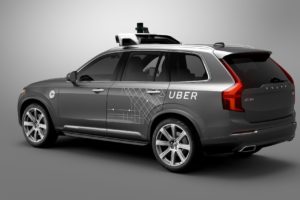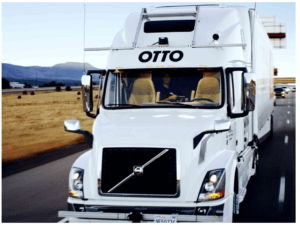Uber’s Autonomous Vehicle Transformation

Autonomous Vehicles and the future of Uber… One day your Uber will drive itself.
“It starts with understanding that the world is going to go self-driving and autonomous, so if that’s happening, what would happen if we weren’t a part of that future? If we weren’t part of the autonomy thing? Then the future passes us by basically, in a very expeditious and efficient way.” – Travis Kalanick, Uber Founder & CEO.
In August 2009, Uber raised $200k to create an app for on-demand private luxury car orders.[1] Today, Uber is valued at $68 Billion[2] and operates worldwide. Moreover, the company’s name has become synonymous with the automotive transportation industry. Since its inception, Uber has offered the value proposition of “Opportunity for All”[3] as an exceptional car service and job creator.
Despite Uber’s scale, the company has a simple business model: connect drivers with people who seek rides. Uber positioned itself as a partner for anyone with an automobile seeking to earn added income. Whenever a ride is facilitated, Uber charges a 20-30% commission for the ride and the driver receives the remainder.[4] In terms of its operating model, Uber focuses on optimizing its software to facilitate the highest possible number of completed rides. To further achieve this, the company also engages in systematic marketing efforts to recruit drivers onto their platform.
Uber frequently claims the role of an ‘economic impactor’ that adds 20,000 jobs every month.[6] However, drivers are Uber’s largest cost.[7] Therefore, the promise of ‘self-driving vehicles’, a technology made possible by advances in machine learning (ML), have become a primary focus for Uber. “By early 2016 [Uber] had recruited hundreds of engineers, robotics experts, and even a few car mechanics to join the venture. The goal: to replace Uber’s more than 1 million human drivers with robot drivers—as quickly as possible.”[8] The focus on autonomous vehicles (AVs) is transforming Uber’s business and operating model. First, Uber is deconstructing its strategic reliance on drivers and replacing that side of it’s business with automotive company contracts. Secondly, Uber is pushing to be more than just a consumer transportation business.
Because Uber does not intend to manufacture AVs, it is implementing a series of strategic partnerships within the automotive industry. Last year, Uber announced a $300 Million deal with Volvo to develop AVs for the business.[9] These vehicles are already being tested on the roads of Pittsburgh.[10]
Moreover, Uber reportedly ordered 100,000 Mercedes S-Class cars to integrate with autonomous capabilities.[12] These actions represent a fundamental shift for a business which has never managed an inventory of vehicles.[13] Uber has been developing the software to power self-driving automobiles by aggressively recruiting elite ML engineers.
“Carnegie Mellon University is scrambling to recover after Uber Technologies Inc. poached 40 of its researchers and scientists earlier this year, a raid that left one of the world’s top robotics research institutions in a crisis… Flush with cash after raising more than $5 billion from investors, Uber offered some scientists bonuses of hundreds of thousands of dollars and a doubling of salaries to staff the company’s new tech center in Pittsburgh.”[14] – The Wall Street Journal
Uber’s focus on launching an AV fleet is shifting the company’s business model past being a consumer taxi service. Specifically, Uber is transforming from an on-demand transportation company to an autonomous logistics business. In this new model, humans become just one of the many items being transported. This summer, Uber spent $680 Million on Otto, a startup building autonomous technologies for big-rig trucks. Uber intends to enter the freight hauling industry by offering driverless trucks to businesses.[15]
Secondly, Uber has recently “launched a global assault” on the food delivery market as it begins launching UberEats in 22 countries.[17] As Uber works to put more AVs on the road, it is not difficult to conceive of a future operation in which Uber’s AVs deliver an array of other products to customers and businesses.
The AV revolution has fundamentally shifted Uber’s business and operating models. Uber is deconstructing the driver side of its two-sided marketplace. If not properly managed, this could have severe consequences for the business. Due to regulatory restrictions AVs are not expected to be ‘fully autonomous’ and on the road until closer to 2030.[18] Therefore, for the next ~10 years’ drivers will remain an integral part of Uber. I think Uber needs to do a better job of framing its AV investments in relation to its drivers. These ventures have generated extensive press and this will likely have a negative impact on driver loyalty. Therefore, Uber needs to begin marketing its vision for the future of its drivers once AVs replace their jobs. For the near future, drivers are the foundation of Uber’s business model and they have the ability to damage the value of Uber’s business if they leave.
(Word Count: 788)
[1] “Uber.” CrunchBase. https://www.crunchbase.com/organization/uber#/entity Web. 16 Nov. 2016
[2] Sorkin, Andrew Ross. “Why Uber Keeps Raising Billions.” http://www.nytimes.com/2016/06/21/business/dealbook/why-uber-keeps-raising-billions.html?_r=0 New York Times. Web. 14 Nov. 2016
[3] Uber. https://www.uber.com/helping-cities/ Web. 15 Nov. 2016
[4] Ovide, Shira. “Uber May Be Making Too Much Money.” https://www.bloomberg.com/gadfly/articles/2016-10-05/uber-s-outsize-commissions-leave-it-vulnerable-to-competition. Bloomberg. Web. 16 Nov. 2016
[5] Uber Newsroom. https://newsroom.uber.com/an-uber-impact-20000-jobs-created-on-the-uber-platform-every-month-2/ Web. 14 Nov. 2016
[6] Ibid.
[7] Edward Taylor, Harro Ten Wolde. “Uber Seeking To Buy Self Driving Car: Source” http://www.reuters.com/article/us-daimler-uber-idUSKCN0WK1C8. Reuters. Web. 15 Nov. 2016
[8] Chafkin, Max. “Uber’s First Self-Driving Fleet Arrives in Pittsburgh This Month” http://www.bloomberg.com/news/features/2016-08-18/uber-s-first-self-driving-fleet-arrives-in-pittsburgh-this-month-is06r7on. Bloomberg. Web. 14 Nov. 2016
[9] Greg Brensinger, Jack Nicas. “Uber to Put 100 Autonomous Volvo SUVs on Road in Pittsburgh” http://www.wsj.com/articles/uber-to-buy-self-driving-truck-startup-ottomotto-1471528978. The Wall Street Journal. Web. 16 Nov. 2016
[10] Brewster, Signe. “Uber Starts Self Driving Car Pickups in Pittsburgh” https://techcrunch.com/2016/09/14/1386711/. TechCrunch. Web. 15 Nov. 2016
[11] Golson, Jordan. “Volvo and Uber ink deal to develop ‘base vehicles’ for autonomous cars” http://www.theverge.com/2016/8/18/12541672/uber-volvo-partnership-autonomous-self-driving-car. The Verge. Web. 16 Nov. 2016.
[12] Ibid. (7)
[13] Ibid. (7)
[14] Mike Ramsey, Douglas MacMillan. “Carnegie Mellon Reels After Uber Lures Away Researchers”http://www.wsj.com/articles/is-uber-a-friend-or-foe-of-carnegie-mellon-in-robotics-1433084582. The Wall Street Journal. Web. 15 Nov. 2016
[15] Russell, Jon. “Uber-owned Otto to offer freight hauling services using autonomous trucks in 2017”https://techcrunch.com/2016/09/27/uber-otto-freight-services-2017/. TechCrunch. Web. 16 Nov. 2016
[16] Davies, Alex. “Uber’s Self-Driving Truck Makes Its First Delivery: 50,000 Beers” https://www.wired.com/2016/10/ubers-self-driving-truck-makes-first-delivery-50000-beers/. Wired. Web. 17 Nov. 2016
[17] Auchard, Eric. “Uber launches global assault on takeaway meals market” http://www.reuters.com/article/us-food-delivery-idUSKCN11W2LX. Reuters. Web. 17 Nov. 2016
[18] Ibid. (7)






It’s interesting to see the development of autonomous vehicle from Uber especially because they talked a lot about bringing more opportunities and additional revenue to its drivers. But I think this is the issue that every company or everyone needs to address. We know AI will replace more and more human jobs, even more for white collar workers than blue collar workers. But how are we going to help people develop new skills and move up to more valuable jobs. If we don’t help people with the transition, it’d be difficult to roll out disruptive technologies.
I have two concerns about Uber moving towards AVs:
1) This is an incredibly risky undertaking and I worry that by trying to be “first to market” in the AV space, Uber opens itself up to a wide array of public perception and regulatory risks. AVs are still very much an emerging technology and the sensor technology is still not where it needs to be for cars to be operating safely on the road, especially when interacting with other human drivers.
2) I echo Bastiane’s concern above. Much of the positive benefit Uber has provided revolves around the fact that it creates many jobs. This transition will eliminate countless jobs which I think has serious potential to hurt Uber’s brand image, a brand image which is already struggling in many parts of the country and the world.
Thanks, Jesse! I strongly agree with one of the points you briefly touched upon – their new plan to hold an inventory of vehicles represents a major change in their operating model. I agree with the issues that Bastiane and Jessica mentioned above, but to me this is the biggest area of concern. Uber’s success can largely be attributed to its inventory-less model that relies on solely matching drivers and riders. The company will have to learn how to manage a fleet of cars, and I worry that this could lead to possible inventory mismanagement and potentially less profitability.
I’m actually less worried about the potential reputational hit Uber may take switching to AVs. In an improving economy, and with more focus given to increasing minimum wage, I wouldn’t be surprised if we reach a tipping point in terms of what drivers make and what passengers want to pay. In 10 years’ time, a lot can change. I think what we actually might find are passengers relieved to go to driverless cars, which will inevitably hold down costs (which hopefully translates to lower prices for passengers). As a result, I don’t think Uber will take a hit at all by replacing their drivers, because at that time their customers may be demanding it.